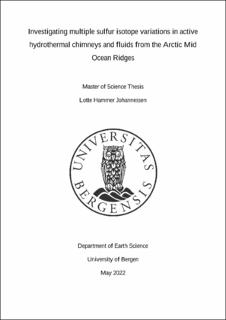| dc.description.abstract | The four different vent fields Seven Sisters, Soria Moria, Fåvne and Loki’s Castle are all located on the ultra-slow spreading AMOR. The Seven Sisters and the Soria Moria vent fields are located on the southern part of the AMOR. Here the ridges are influenced by the Icelandic hostspot resulting in higher magma supply, higher spreading rates, and thicker crust compared to the northern parts of the ridges. Fåvne and Loki’s Castle vent fields are located further north where the ridges have a limited magma supply, thinner crust, deeper water depths and exposed ultramafic mantle rocks. There is relatively scarce knowledge on subsurface processes in ultra-slow spreading related hydrothermal systems. Since sulfur plays a major role in the circulation system of high temperature hydrothermal systems, its multiple stable isotopes are used as a tool to gain knowledge about their subsurface processes. Multiple sulfur isotopes were measured in sulfides and fluid samples from active high temperature chimneys in the four different vent fields Seven Sisters, Soria Moria, Fåvne and Loki’s Castle. This thesis explored how variations in the geological settings (magmatic input, sedimentary input, host rocks, fluid temperature, and depth) of the vent fields were reflected in the sulfur isotope ratios, to increase our understanding of hydrothermal sulfur cycling along the AMOR. The framework for interpreting the isotopic composition in sulfides were the combination of the anhydrite buffer model and the two-component mixing model, to distinguish between the different reactions in the circulation system that affected the isotopic composition of sulfides. The combined δ^34 S and ∆^33 S data from high-temperature hydrothermal fluids and sulfide minerals in the four vent fields on the AMOR demonstrates that variations in their geological setting are reflected in the multiple sulfur isotope ratios. Multiple sulfur isotope data reveal variation in reaction zone temperatures (250°C, 270°C, 350°C, 450°C) for the four investigated vent fields, that appears to be correlated to vent field depth. Their difference in reaction zone temperature appears to affect them to have varying contribution of sweater sulfate of 0%, 10%, 30% and 50% to the isotopic composition of sulfides, though this is also affected by rock type that fluids interact with. The multiple sulfur isotope data also indicate that isotope exchange between anhydrite- or barite-derived sulfate and sulfide does not reach equilibrium at the AMOR vent fields, despite the wide range of subsurface temperatures (250°C-450°C). | |
